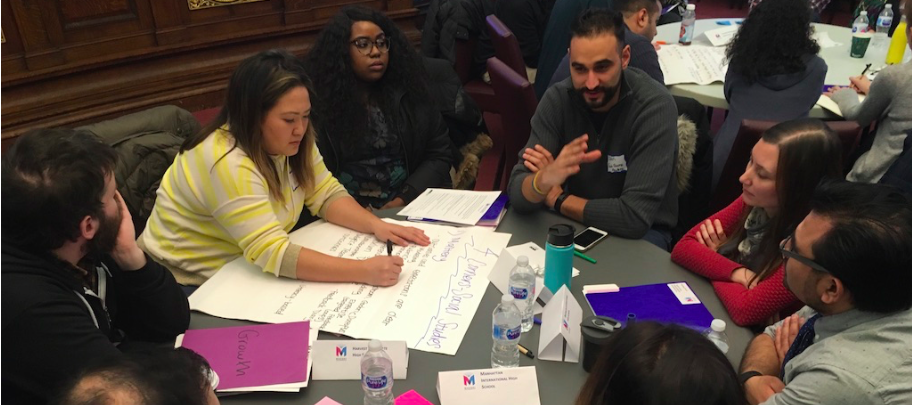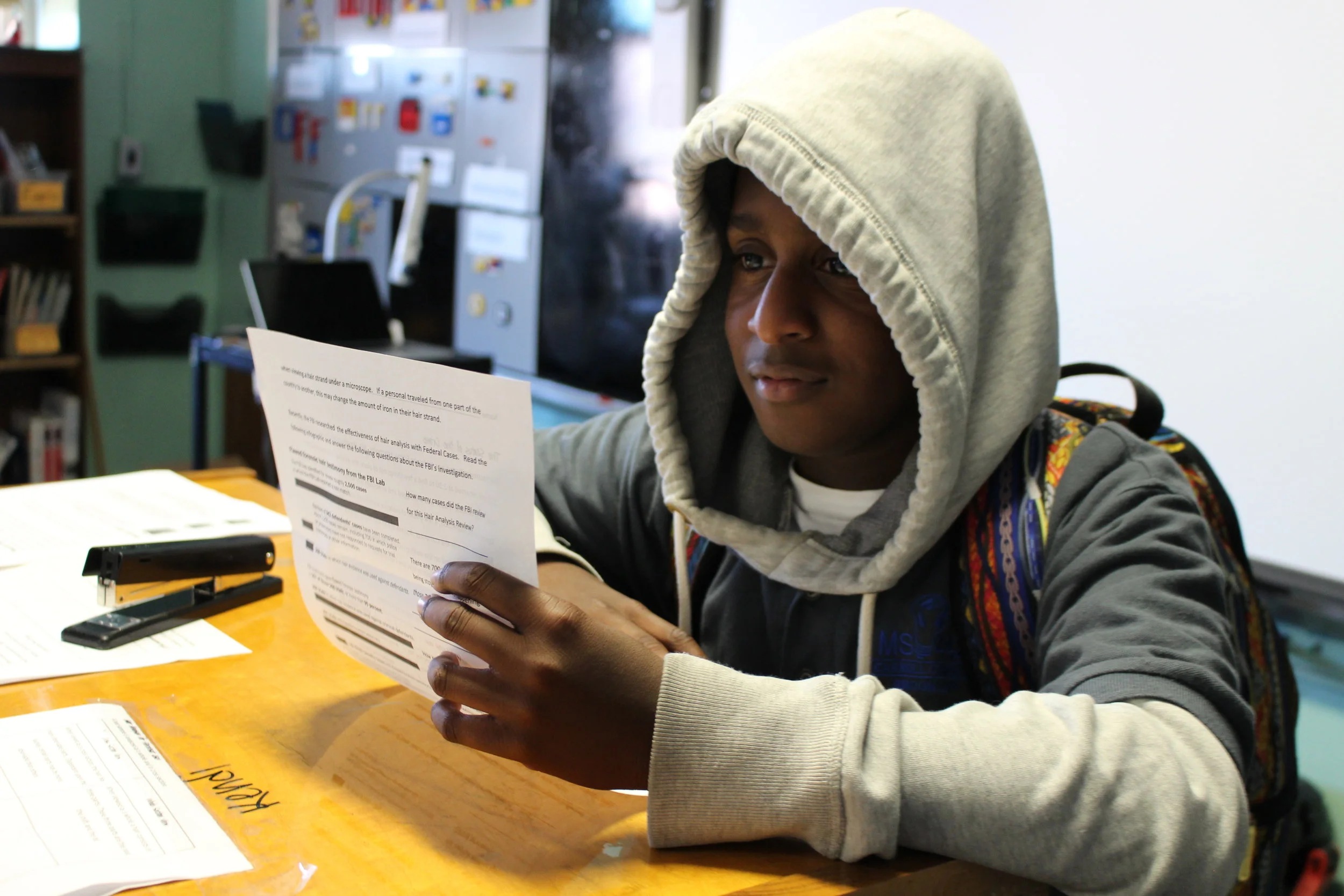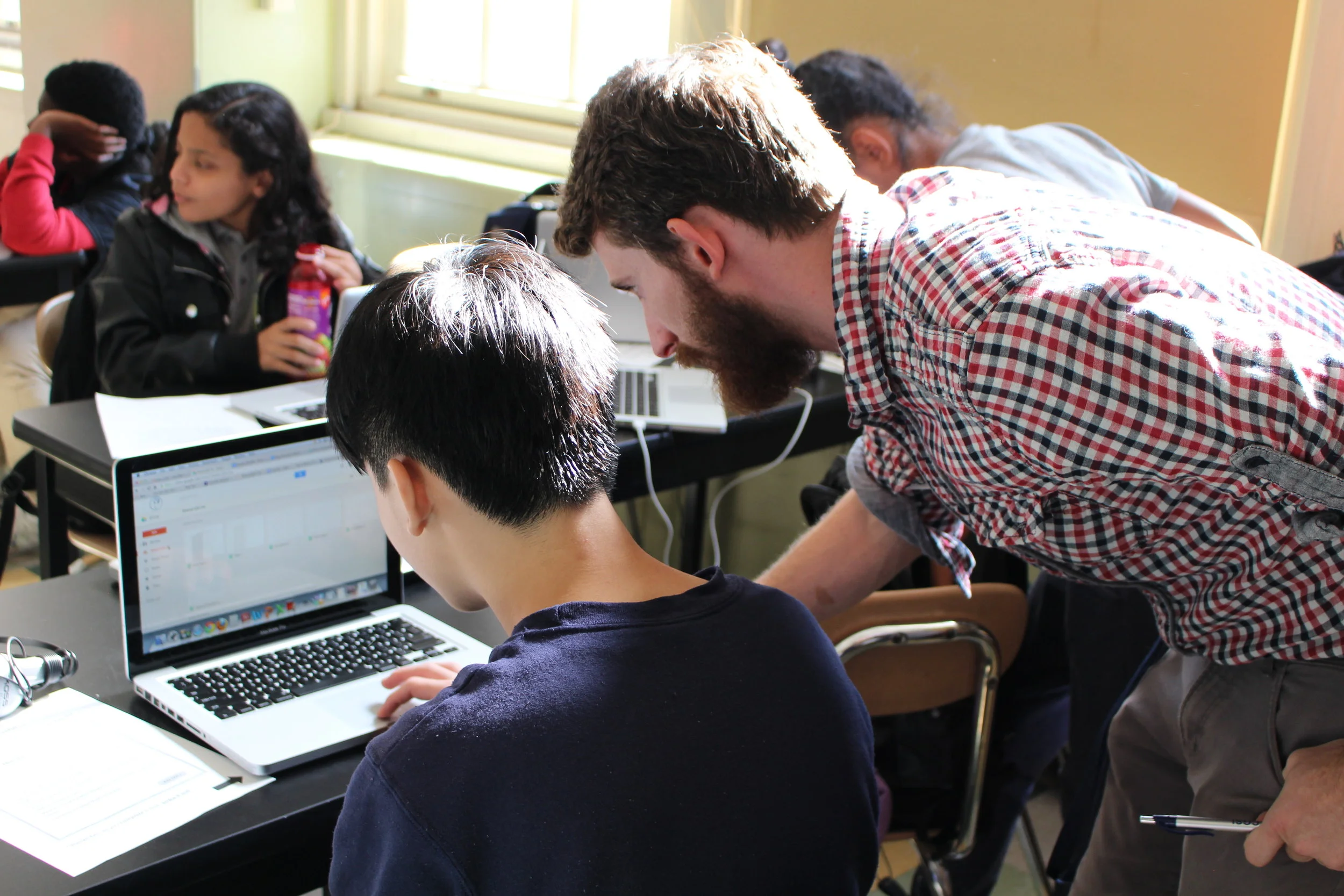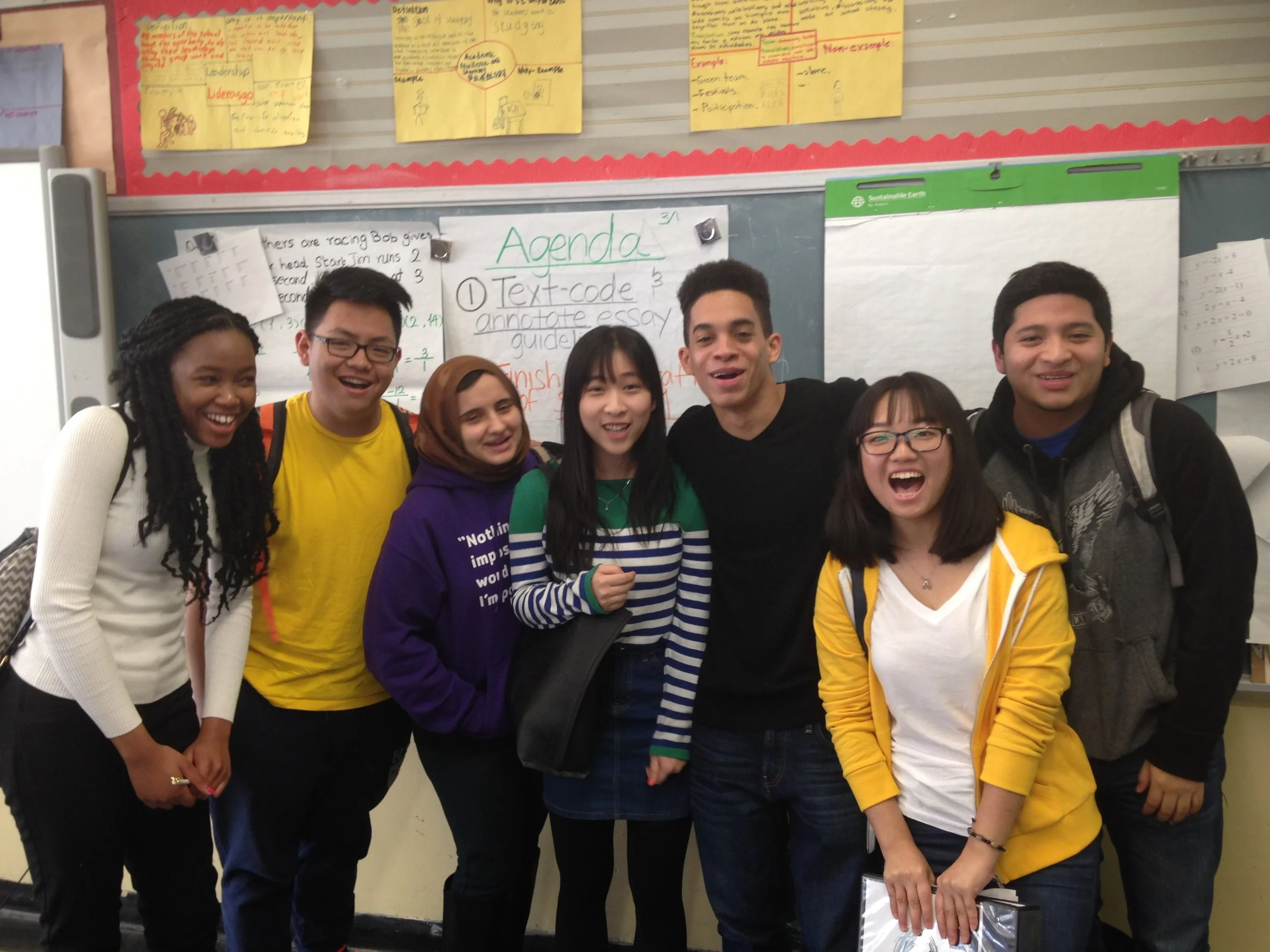Tell us about your problem-solving class. What do students do? Why was the class created?
About three years ago at this time, we were noticing that while we had strong programs, some of our kids needed additional support. So, through that, the problem-solving classes developed to complement what was happening in the traditional math class. Students do game-like challenges to get them thinking mathematically in an engaging way.
These were additional math classes to the core math class? What grades were involved?
Yes. In our first year, we started with our sixth graders. Since they were new to our school, we wanted to get them into the problem-solving mindset that we wanted to build. This year we brought it up to our sixth graders and our seventh graders.
How does problem-solving support students' success in math generally?
I like to summarize problem-solving class as critical thinking class. We don’t necessarily worry about the answer—we try to encourage kids to have metacognition moments, like: “What are you thinking about in this moment in order to help you solve this question?” We want to build on strategies, so that they can take those strategies into real-world situations they deal with, or just into a good old-fashioned math problem, where they’re going to have to sit there and build upon their prior knowledge and persevere through solving it.
We found that when it came time to deal with a more involved math problem, kids kind of lost interest—they didn’t stay focused, even if they had the math skills. But problem-solving class pushes kids to be okay with grappling with something that isn’t necessarily easy at first, and trying to figure it out.
I imagine in addition to building their skills, it has also built their confidence.
I think so. I will settle on 1-2 questions in maybe most class periods. They always start off with, “I need help with this,” and I laugh and walk away. I just kind of leave them to get messy with it. Usually they can get there, or at least have ideas in place to get there. It’s funny, it’s now the end of May, and there are still situations where it’s been two minutes and they raise their hands and I say, “It’s May, I didn’t answer this question in September and I’m not going to start now.”
Do you see an effect on their regular math classes?
I do. As far as sixth grade problem-solving goes, I do. They solve problems around tables, and that’s because so much of the sixth grade unit is built around those ratio units, where they look for patterns, and they can find their answers together. They look on a graph, and they can find their answers. I build off that idea, so that I work in conjunction with the team.
How do you have 25 students doing 15 things in one class session? How do students experience it? How do you keep track of what everyone is doing and give feedback?
We are helped out by the fact that we are an ICT school, so there are two teachers. Within some of our bigger projects, my co-teacher and I will specifically say, “I’m the point person for this half of the class,” and “You’re the point person for this half of the class,” so that instead of getting through it with 25 different kids in this unit, I’ll get through it with maybe 12 or 13, and that makes it a little easier. We’ll also do things like make use of technology. We have 1-to-1 technology for the students, which allows us to have a “sum up” time, in a Google Doc, where kids can say what they did that day and get feedback.
So in a way, you can support them without checking in with every child in the class during class time?
Yes, as you begin to teach kids how to do this, you can give them five minutes at the end of the class and say “OK, go to your Google Docs, and summarize your work for today.” And that gives us the opportunity to just read the independent reflections, and you can very quickly see who understood their goal for the day, and who didn’t, and that sets up what you’re going to do with the kids for the next class.
How do you go about giving feedback to the ones who are struggling?
It depends on what we’re up to with a project. There are days when some kids are starting to do the “Do Now” and a teacher will pull a group of 4 students to the back and say something like “I saw that you guys were having a similar situation, you were struggling with this, let’s clarify that, so that we can proceed from there.
Another thing that can be useful is, using the technology, you can do ShowMe lessons or PowerPoints, Screencasts, where you can be talking the kid through something. You can really have a lesson set up for a kid who didn’t understand something and needs a refresher, or a kid who’s really advanced, and needs to move ahead of everyone else. You can spend 15 minutes setting up an independent lesson for them, and they can hit play and go through their lesson on their own.
Do you have advice for teachers who want to start allowing students to progress asynchronously, but don't know how to get started?
I think what teachers have to be most prepared for is that so much of their planning has to be on the front end. You know, you’re not just making one lesson plan then, you’re making bigger paths for kids to follow. If there’s technology available, that’s probably going to allow for the easiest way to make that happen. If there’s not technology available you can still do it, but you have to be ready to go with paper, pretty regularly, and stay organized with folders. If you have the technology, it’s easier for kids to progress asynchronously, using different online platforms, or just Google Folders, Google Docs. Google Docs is a great help in allowing kids to work at their own pace.
Having the students access work themselves is a good way of doing it?
Yes, that works, and also it gives the kids that independence. If you give them a good checklist, you know, instead of having them always asking, “Well, what do I do now?” you can tell them “You finished your step 3, look at what your step 4 is.”
What is the role of distributive leadership at your school? How does this collaborative environment empower teachers to go for it with mastery?
We have a really strong chair leadership model here. We currently only have one administrator. Last year we had a principal and an assistant principal, and our principal who left to go to the district office really set this up for us, and our AP has moved into the principal’s spot, and so over the past few years we have really built capacity by creating positions, like our department heads, who are responsible to check in with our teams by subject areas.
We have grade teams that make sure all systems and routines are set up for a grade, that also allows for looking at student work protocols for different students in each subject. We also have branched out and created focus leaders for different topics in our school. So, this year we have a technology focus leader, a mastery focus leader, a mentorship focus leader, and we have an extended learning opportunities focus leader. In addition, our department heads meet weekly with the administration so that the eight of us can be on the same page. The principal obviously knows what’s going on with all of us. Just as things can overlap, it gives us an opportunity to have those weekly discussions.
Our staff is open to communicating and trying different things. The administration has set the tone that “I’m OK if you try something and it doesn’t work.” That kind of attitude to experiment in our own classrooms and feel OK about that has provided us with the opportunity for people to be more open minded about everything.
As far as mastery specifically goes, then, we are given flexibility to set up mastery in different ways based on different departments. For example, the literacy department wanted to focus on ten shared outcomes that they use across grade levels, that they even use with the social studies team. Math and science wanted to handle it differently, we had more, we wanted to make it more skills and practice-based, and make it a little more specific like that. So we went to our administrator, we said this is what we think works for us, she said, “OK, give it a shot,” and it’s worked for us, so we have been allowed to continue that. And we can do that because there’s that flexibility to say, “This might not have worked well, this did work well.” There’s openness to try something.
For example, Jared Sutton, who is our mastery point person, he likes coding, and he used GoogleScripts to create an online grading/tracking platform for us. That’s how he spent his summer. It has the capabilities to have not just our own mastery-based grading platform built into it, but it also has our mentorship program built into it, and it has our behavior trackers built into it.
You have a completely customized grading system?
Yes, Jared thought he could figure out a way to make more things work together, and he locked himself in a room over the summer and did that.
How does mastery work for high-performing students and special needs students?
Students are evaluated the same way, they receive the same grades on any assignment that they hand in. My students receive different assignments or additional assignments along the way, yes, but the grade values that they receive are always based on a learning outcome that’s tied to their grade level, and that’s what they receive.
In order for us deem a student as meeting a learning outcome, we require they have to have met or exceeded that learning outcome in at least three trials. So, one of those high performing students might need only three times to meet the outcome, taking the form on a exit ticket, a quiz grade, and a project. And they might have done it three times, and done that learning outcome well, so they’re good.
Some of those kids might need additional time to meet that outcome, and that’s fine. They might need seven opportunities to meet it, seven different trials. We’re not concerned about when the student meets that learning outcome, just whenever they get to that date, the student is able to get that concept and meet that outcome. So if they meet it in October rather than February, it doesn’t really matter to us. We actually moved our report cards to June—only in June. Throughout the year we give progress reports, based on what’s in our online platform, where we say to this point, your child has met this percentage of learning outcomes that have been assessed. It may say what they’re on track to do, but still saying nothing is set in stone.
So with a high performing student, if it only takes them three shots to achieve an outcome, is there a point in the year when you give them additional challenges?
It’s not like they get to October and they’ve finished the sixth grade outcomes, so they can move to the seventh grade outcomes. Throughout the units they’ll have additional opportunities [to stretch their skills]. Additionally this year we started an intensive program, where instead of kids only being in traditional ICT classes, they are homogeneously grouped in grades, based on skills, and these groups change flexibly. So in November we noticed that we have 13 high achieving sixth grades who are pretty much beating all of the math and learning outcomes, so those kids are grouped together, and they started doing some advanced work two times a week all mixed together to work on additional concepts. This also allows for our seventh and eighth graders to – the seventh graders start to do some of the eighth grade algebra work as seventh graders.
How does (or how can) MBG make teachers better at their jobs?
It can work, providing that there’s clarity to the system—you can’t hold anything back—teachers, parents, students need to understand what it means. The goal of mastery is that everyone understands everything. And for some people that comes naturally, and some people have to work really hard at it. So then you have to put the time and effort into working really hard at it. It’s not OK for kids to be happy with an “A” for approaching, getting a 2 in a different kind of competency based grading system, there has to be that realization that makes you strive to get those threes and fours—those “meeting”s and “exceeding”s. Until those things go together, it’s a hard system. When families don’t care about things like that, it doesn’t work as well.
It helps teachers prepare better. You can very clearly see where students can be successful, and you can very much see what their next steps are.

















